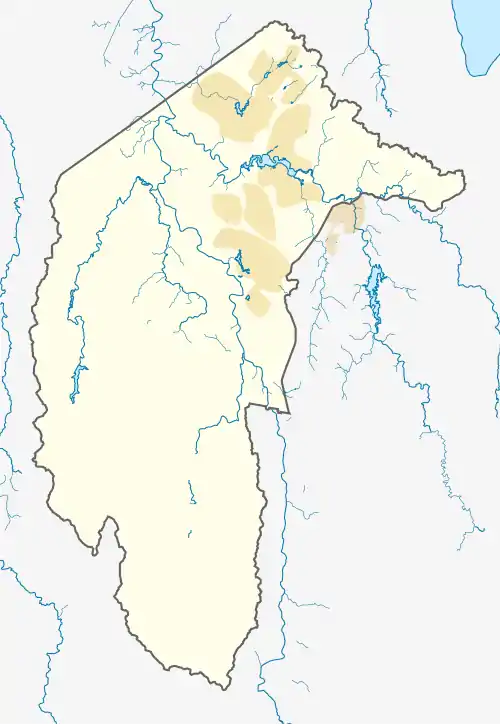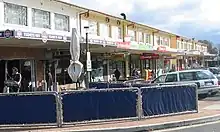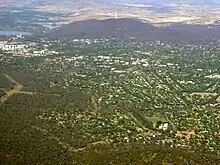| Ainslie Canberra, Australian Capital Territory | |||||||||||||||
|---|---|---|---|---|---|---|---|---|---|---|---|---|---|---|---|
 Wakefield Gardens Housing Precinct house | |||||||||||||||
 Ainslie | |||||||||||||||
| Coordinates | 35°15′46″S 149°08′39″E / 35.26278°S 149.14417°E | ||||||||||||||
| Population | 5,376 (2021 census)[1] | ||||||||||||||
| • Density | 1,536/km2 (3,980/sq mi) | ||||||||||||||
| Established | 1928 | ||||||||||||||
| Postcode(s) | 2602 | ||||||||||||||
| Elevation | 590 m (1,936 ft) | ||||||||||||||
| Area | 3.5 km2 (1.4 sq mi) | ||||||||||||||
| Location |
| ||||||||||||||
| District | North Canberra | ||||||||||||||
| Territory electorate(s) | Kurrajong | ||||||||||||||
| Federal division(s) | Canberra | ||||||||||||||
| |||||||||||||||
Ainslie is a suburb of Canberra, Australia in the North Canberra district.
The suburb is bounded by Limestone Avenue and Majura Avenue to the west and north, Phillip Avenue to the north-east, Mount Ainslie to the east and Quick Street to the south.
Ainslie is within walking distance of the City, the nature trails of Mount Ainslie, the Australian War Memorial and the many restaurants of Dickson. It has many attractions: a central location, with equally easy access to the CBD and the bush trails of Mount Ainslie; the abundance of charming early twentieth-century, heritage-listed houses; mature deciduous street trees and general leafiness; and a vibrant local shopping centre.
Suburb amenities

The local shops are located in the middle of Ainslie, and there is an IGA store,[2] a cafe,[3] restaurant,[4] liquor store, pharmacy, laundrette,[5] Pilates studio and newsagent. The suburb has a playschool, The Inner North Playschool,[6] a preschool (Baker Gardens Preschool), the Ainslie Football Club, and the Ainslie Fire Station, which serves the North Canberra area. The North Ainslie Primary School is located in the suburb, but Ainslie School, one of Canberra's oldest, is located in Braddon on the western side of Limestone Ave (Braddon was originally called 'Ainslie' with the current Ainslie and another early neighbouring suburb, Reid, were originally called 'North Ainslie' and 'South Ainslie' respectively).[7] Ainslie Village which is actually in Campbell, provides accommodation for homeless adults, or those at risk of homelessness.[8]
Ainslie residents can access Mount Ainslie simply by walking uphill. There is an easy paved walk to the top, and also a "goat track" straight up the side of the hill. Kangaroos come down from the mountain at night and eat grass from the nature strips in front of local houses.
The Anglican All Saints Church, built in the 1860s of stone, is located on Cowper Street in Ainslie. It was relocated from Sydney in 1957 and originally served as the railway terminus at Rookwood Cemetery. It is listed by the ACT Heritage Council.[9]
Design
The suburb is characterized by leafy streets, and mainly by detached single dwelling houses. Many see a "village" atmosphere around the many small parks. Ainslie has experienced 'in-fill' development in recent years, both in the form of dual occupancy dwellings (where two dwellings are constructed on a block which previously contained one house) and medium-density development, especially at the Limestone Avenue ends of Cowper Street and Angus Street and, more recently, on the site of the former service station at the Ainslie shops.
History


The suburb was named after James Ainslie, a veteran of the Battle of Waterloo, the "first overseer of 'Duntroon Station' in Canberra who was employed by Robert Campbell in 1825 to drive a mob of sheep south from Bathurst 'until he found suitable land'; Ainslie chose the Limestone Plains (the Canberra district) and was overseer for ten years before returning to Scotland."[10]
James Ainslie was reputed to have camped in 1825 under gum trees at what is now Corroboree Park.[11] Iris Carnell, born in 1900 and one of the original inhabitants of Paterson Street in the 1920s, recounted in 'Voices of Old Ainslie' that her mother, Celia Tong, born at Lanyon in 1871, remembered as a little girl what is now Corroboree Park as a scene of aboriginal corroborees. She said the aborigines used to sit around the tree now near the barbecues which has four trees growing from its centre.[12]
Ainslie has three housing precincts planned on Garden City principles that were gazetted onto the ACT Government's Heritage Register in 2004. The first stage of the Corroboree Park precinct was constructed between 1925 and 1927 to accommodate tradesmen for the construction of the city.[13] The Alt Crescent precinct was designed for the members of the Federal Capital Commission and built in 1926. The houses were originally occupied by the founding staff of the FCC. The curved street design appears to derive from Walter Burley Griffin's original plan for Canberra which shows a small crescent off Limestone Avenue at the end of Ainslie Avenue.[14] The first stage of the Wakefield Gardens precinct was constructed between 1925 and 1929 to accommodate lower income public servants and workmen for the opening of the new Parliament House in Canberra in 1927.[15]
The division (or suburb) name Ainslie was gazetted by the Government in 1928. The streets of Ainslie are named after pioneers and legislators.[10]
Iris Carnell also records that when the then-Duke and Duchess of York came to Canberra to open Parliament House in 1927, the Duchess, later Queen Elizabeth The Queen Mother, expressed an interest in visiting a typical local family. She was invited to tea with the Truesdale family at 20 Corroboree Park (on the northern corner of Higgins Crescent).[16]
Originally a predominantly blue-collar suburb with a high proportion of public housing, Ainslie has gradually gentrified, with properties regularly fetching more than $1 million. Perhaps paradoxically, among the most sought-after properties in the suburb are the heritage-listed cottages built during the conservative governments of Stanley Bruce and Joseph Lyons, which are set mainly among European trees.
Open space
Ainslie has many parks and open spaces.
- Corroboree Park is shaped like a semicircle, and is associated with the Aboriginal use of the area prior to European settlement in Canberra. The park was created around 1925 around what is known as the 'Corroboree Tree' located in the park. Ainslie Community Hall, which is located in Corroboree Park, is socially significant as one of the early meeting places in Canberra. The wooden hall was erected in 1927 and the adjoining 1920s school building was relocated to its current location from Russell. The hall is often used for social gatherings, meetings and classes such as yoga and dance. The three courts for the Ainslie Tennis Club (established in 1927) were built using voluntary labour. The tennis club planted many of the trees in the park.[13]
- It contains several sports ovals, one of which is part of the Ainslie Football Club.
- It contains North Ainslie Primary School which has a generous oval.
Demographics
In the 2021 census, the population of Ainslie was 5,376, including 99 (1.8%) Indigenous persons and 4,029 (74.9%) Australian-born persons. 72.5% of dwellings were separate houses (compared to the Australian average of 72.3%), while 16.8% were semi-detached, row or terrace houses (Australian average: 12.6%) and 10.1% were flats, units or apartments (Australian average: 14.2%). 39.1% of the population were professionals, compared to the Australian average of 22.2%. Notably 24.6% worked in central government administration, compared to the Australian average of 1.2%, although the ACT-wide average is a similar 17.1%. 56.5% of the population had no religion, compared to the Australian average of 38.4%.[1]
Politics
| ||||||||||||||||||||||||||||||
Ainslie is located within the federal electorate of Canberra and it is represented by Alicia Payne for the Labor Party. In the ACT Legislative Assembly, Ainslie is part of the electorate of Kurrajong, which elects five members on the basis of proportional representation, two Labor, two Greens and one Liberal.[19] Polling place statistics are shown to the right for the Ainslie North polling place at Ainslie North Primary School in the 2022 federal[17] and 2020 ACT[18] elections.
Geology

Calcareous shales from the Canberra Formation from the Silurian period is overlain by Quaternary alluvium. This rock is the limestone of the original title of Canberra "Limestone Plains". Mount Ainslie itself is composed of the Ainslie Volcanics.[20]
Notable residents
References
- 1 2 Australian Bureau of Statistics (28 June 2022). "Ainslie". 2021 Census QuickStats. Retrieved 15 July 2022.
- ↑ http://ainslieiga.com.au/
- ↑ Breizh Cafe
- ↑ http://www.pulp-kitchen.com.au
- ↑ http://www.ainslielaundrette.com.au
- ↑ "The Inner North Playschool". Retrieved 12 March 2014.
- ↑ "Ainslie 1928" (PDF). Archived from the original (PDF) on 8 March 2014.
- ↑ "Ainslie Village General Information" (PDF). Argyle Community Housing Ltd. 1 November 2013. Retrieved 16 November 2015.
- ↑ "20065. All Saints Church (Entry to the ACT Heritage Register)" (PDF). ACT Heritage Council. Retrieved 12 March 2014.
- 1 2 "Suburb Name search results". ACT Environment and Sustainable Development. Retrieved 9 February 2014.
- ↑ Lyon 1995, p. 1.
- ↑ Lyon 1995, pp. 1, 15–16.
- 1 2 "20025. Corroboree Park Housing Precinct (Entry to the ACT Heritage Register)" (PDF). ACT Heritage Council. Retrieved 14 March 2014.
- ↑ "20027. Alt Crescent Housing Precinct (Entry to the ACT Heritage Register)" (PDF). ACT Heritage Council. Retrieved 12 March 2014.
- ↑ "20046. Wakefield Gardens Housing Precinct (Entry to the ACT Heritage Register)" (PDF). ACT Heritage Council. Retrieved 12 March 2014.
- ↑ Lyon 1995, pp. 21.
- 1 2 "2022 Federal Election: Ainslie North - Polling Place". Australian Electoral Commission. 10 June 2022. Retrieved 27 August 2022.
- 1 2 "2020 Results for Kurrajong Candidates at Ainslie North Polling Place". ACT Electoral Commission. 11 November 2020. Retrieved 15 July 2022.
- ↑ "List of elected candidates - 2020 Election". ACT Legislative Assembly. Retrieved 15 July 2022.
- ↑ Henderson G A M and Matveev G, Geology of Canberra, Queanbeyan and Environs 1:50000 1980.
References and further reading
- Macdonald, Emma (14 February 2014). "A weekend in your suburb: 36 hours in Ainslie". The Canberra Times. Archived from the original on 14 February 2014.
- Lyon, Louise, ed. (1995), Voices of Old Ainslie, National Capital Printing
- Wright, Tony (5 February 2010), "Misadventures in the People's Republic", The Age, archived from the original on 7 February 2010, retrieved 16 September 2013